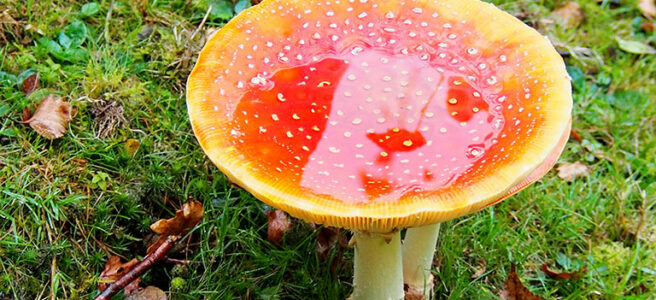The New Forest National Park is famous for its profusion of year-round mushrooms and fungi, and none more so than the abundant and colourful blooms which appear during the autumn months.
They are critical to sustaining the forest ecosystem, and the National Park is full of Rangers and locals who actively police the area for commercial pickers. Picking mushrooms for your own culinary use is allowed. But the forest has in recent years been at the mercy of commercial pickers. These are large groups who come and strip the forest bare of mushrooms and fungi to sell for profit – which not only attracts a hefty fine but also destroys the forest’s delicate habitat and ruins it for everyone else.
View this post on Instagram
The ancient woodlands of the New Forest are home to many more mushrooms and fungi than most other locations in the UK. The number of varieties comes in at around 2700, so there’s a pretty good chance (if you know what to look for) that you’ll see them if you book a stay at one of our New Forest Cottages.
Mushrooms and fungi grow wild all over the New Forest. Different species have preferred habitats depending on tree type, sunlight, soil, bogs and even dung – and with thousands of New Forest ponies, cattle, pigs, deer and woodland wildlife, there’s a plentiful supply! A large number of mushrooms and fungi thrive in the deciduous woods of the forest’s oak and beech trees, particularly in and around dead and decaying timber, moss and bracken. But, don’t forget the vast expanses of rolling heathland and grassy meadows, as there are beautiful species who choose to flourish out in the open, soaking up full sunlight.
View this post on Instagram
Mushrooms and fungi grow in a multitude of shapes and sizes from squat, flat plates you could easily think is a stone, to frilly, wispy, delicate fingers twisting through grassy banks amid twigs and plants. Then there are the gigantic mounds of sinister alien-looking mounds just daring you to get closer for a curious look. The colours are quite mesmerising too. From pale cream and white neutrals to fiery crimson and gothic violet plum, through to grotesque ripples of slime green, grey and black.
View this post on Instagram
Keep a lookout when out walking. Lovely locations to explore on foot include Langley Wood Nature Reserve near Redlynch in the north of the forest. On the western border of the National Park are the woods just outside Linwood near Ringwood, and Denny Wood and Bolderwood, both near Brockenhurst, are both well known as fungi hotspots.
View this post on Instagram
Never, ever eat mushrooms or fungi unless you are absolutely certain you know what it is you are eating. If in doubt – DO NOT EAT THEM!
A really pleasant morning or afternoon can be spent joining a small group for a New Forest fungi foray. These are escorted walks with experienced mushroom and fungi experts who can teach you all about New Forest mushrooms and fungi. They will be able to identify some of the thousands of species and explain their growing patterns, culinary and medicinal properties. Most important of all, they will identify which species you find are inedible, poisonous and dangerously deadly. For mushroom and fungi tours try Edible Bush, Forage London, Wild Food UK and Wild Heritage.
View this post on Instagram
Some distinctive species to look out for:
The Yellow Stag Horn is small, elegant and almost sculptural in shape, with an uncanny resemblance to the antlers found on the stags who roam the New forest. Look for them in decaying coniferous trees.
View this post on Instagram
The Deathcap is considered one of the most poisonous in our country. It is easily confused with other edible mushrooms, which is why you should never pick any mushroom or fungi unless you are an expert or are with one. Deathcaps grow throughout the New Forest on their own, in a fairy-ring or a small group. Just a small morsel of the Deathcap can result in death with the body suffering vomiting, diarrhoea and organ failure.
View this post on Instagram
Giant Polypore really are enormous in fungi terms, growing to two and a half feet in diameter. Look at the base trunks of beech and oak trees, where they pile on top of each other in terraced fan-shaped shelves.
View this post on Instagram
The funkily named Chicken of the Woods prefers our historic oaks as home to spore and grow, although it can be seen on other tree species. It’s a tasty find if identified properly.
View this post on Instagram
Hedgehog Fungus is also known as Wood Urchin or Wood Hedgehog due to its pretty texture of tiny spines. You’ll find these little fungi in groups or on their own in coniferous and broad-leaved woods throughout the forest.
View this post on Instagram
The Fly Agaric is a beautiful but poisonous fairy-tale looking fungi. You’ll see them all over the New Forest, often under or close to birch trees.
View this post on Instagram
The mighty and ‘bloody’ Beefsteak Fungus can grow to a huge size and likes oak and sweet chestnut trees. Its deep red flesh is so dense it can easily pass as steak, especially when squeezed and blood-red juices ooze as a piece of meat would.
View this post on Instagram
The New Forest is spectacular in the autumn months. Take a look at our portfolio of 140 New Forest Cottages and find your perfect short break away.

